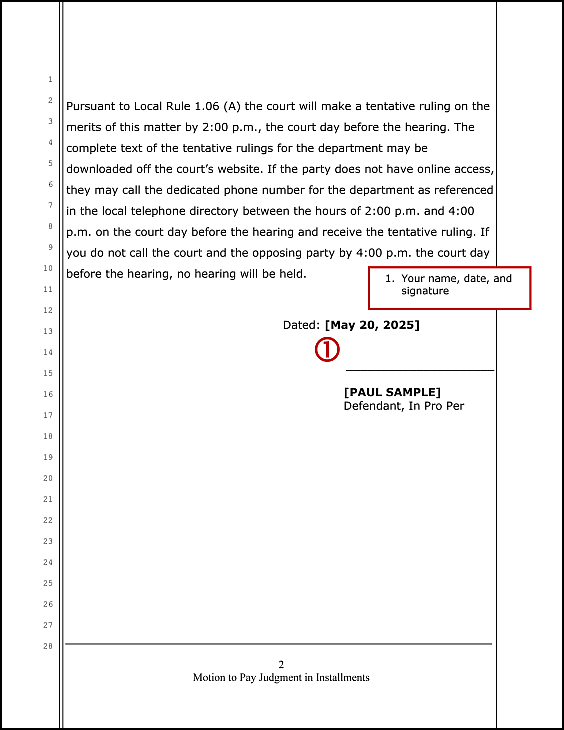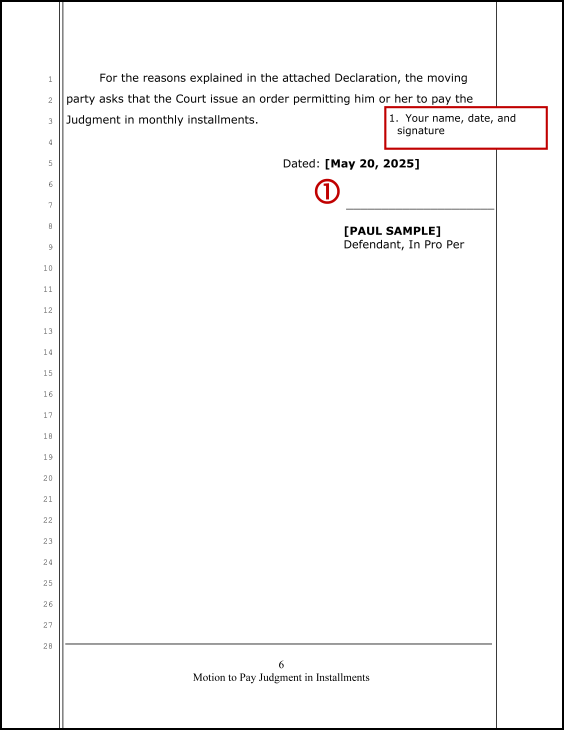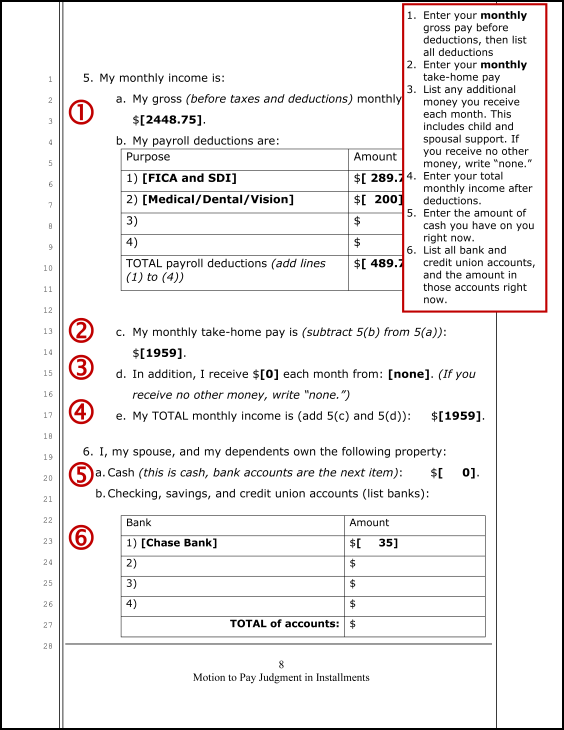Motion to Pay Judgment in Installments: Requesting Installment Payments
California Code of Civil Procedure (CCP) § 582.5 allows a judgment debtor in a limited civil case (amount demanded is under $25,000, or under $35,000 if filed after Jan. 1, 2024) to ask the court for an order allowing the judgment to be paid in installments. This request is made by a formal noticed motion, and may be granted for good cause at any time after the judgment; even if the judgment was entered by default because the debtor never answered the complaint.

Templates and Forms
In determining the amount of the installment payments, the court may consider any of the factors that would be considered in reviewing a request for a claim of exemption, so the amount and source of the judgment debtor’s income are directly relevant to the court in reviewing this request. If the requested installment payment is less than 25% of your wages after taxes, you will need to justify why you need the money for the necessities of life, or show that it is somehow exempt from collection. For more information on funds that are exempt from collection, see our article on Exemptions from Enforcement of Judgment.
Step-by-Step Instructions
1
Reserve Your Hearing Date and Determine Filing and Service Deadlines
This information is for Sacramento. If your case is in a different county, do not follow these instructions. Instead, call the clerk or visit the court website in your county to find the correct information.
Determine the department and time of the motion
This is considered a “Law and Motion” matter, which are heard in Department 53 at 1:30 p.m. or Department 54 at 9:00 a.m., Tuesday-Thursday. To determine which department your hearing will be in, check your case number. Odd numbered cases are heard in Dept. 53, even numbered cases in Dept. 54. (There are occasional exceptions, so if you’ve been assigned to one or the other in the past, use that one.)
Reserve the date for the hearing
In Sacramento’s Departments 53 and 54, you must reserve a court date through the court’s online reservation system.
To use the online system, go to prod-portal-sacramento-ca.journaltech.com/public-portal/ and choose “Reservation System (CRS).” You must have a free account on the system to use it.
Before you log on or call, figure out if there are any days you will not be available during the next couple of months. For instance, you don’t want to pick a date when you know you will be out of town.
You must choose a date far enough in the future that you can both file and serve your motion on time. Scheduling it four weeks in advance generally gives a comfortable margin for most types of motions. Usually, the first available date will be further away than that.
Determine the legal deadline to file the motion in court
Tip: File the motion as soon as possible. Your reservation is not final until the motion has been filed and any fees paid.
The last legal day to file with the court is at least sixteen court (business) days prior to the motion date (CCP § 1005). “Court days” are Monday through Friday, excluding court holidays. To determine whether a particular filing date will meet this deadline, start counting backwards on the day before your hearing until you reach the sixteenth court day. (CCP § 12c)
For example, suppose your reservation is for Monday, June 18. You would start counting backward using the previous court day, Friday, June 15, as day one, as shown in the calendar below. Skip weekends and court holidays (there is one court holiday in this example, which is Memorial Day, May 28). The sixteenth court day before the hearing would be May 24, which would be the last day that the motion could be filed.

Make a note on your calendar to file the motion by this date. Do not miss this deadline. The court will cancel the hearing and you will have to start over.
Determine the legal deadline to serve the motion on the other parties or their attorneys
You must have all other attorneys (or self-represented parties) served with a copy of the motion, then have the server fill out a Proof of Service which you file along with the motion. This means that someone over the age of 18 who is not a party in the case must either mail or personally deliver a copy of the motion and related documents to them. There is a strict deadline to do this (earlier is always fine).
Personal service: 16 court days before the hearing, the same as the minimum filing deadline. The server can fill out Proof of Personal Service—Civil (POS-020).
Service by mail: 16 court days before hearing PLUS five calendar days before the hearing (more if the mailing address is outside California). (CCP § 1005). The server can fill out Proof of Service by First-Class Mail—Civil.
“Calendar days” include weekends and holidays, but if the final day lands on a weekend or holiday, it is pushed back to the previous court day.
Make a note on your calendar to have the motion served by mail before the deadline. If you miss the mail deadline, you can still have the motion served by personal service up until 16 court days before the hearing. If you miss that deadline, you will have to cancel your court date and start over.
2
Prepare the Motion
There is no pre-printed form for this motion. You will need to customize a motion on “pleading paper.” Instructions and a sample motion are at the end of this guide.
Parts of a Motion
A request to deem an opposing party’s admissions true is made through a motion. A motion is a request made in a case asking the court to issue an order of some sort.
A written motion consists of four parts:
- Notice of Motion;
- Motion;
- Points and Authorities; and
- Declaration
The Notice of Motion lets the opposing party know when and where the motion is scheduled to be heard, while the Motion lets the court and the opposing party know what is being requested. The Points and Authorities explains to the court and the opposing party the legal basis of the motion, while the Declaration provides evidence, sworn under penalty of perjury, supporting the motion.
The parts can be filed as separate documents or combined into one document, as in our template motion.
Modify the Template Motion
There is no Judicial Council form for this procedure. Instead, the relevant documents must be typed on 28-line pleading paper. A customizable template may be downloaded from this link:
More information about how to fill the forms out is included on the sample at the end of this guide.
3
Copy and Assemble Your Documents
Make four (4) copies of your Motion. One of these copies is to be served on the other party’s attorney (or the other party, if they do not have an attorney); the original and the other three copies are to be filed with the court. Staple each of the copies, but leave the original unstapled so the court can scan it.
Attaching Exhibits
For each exhibit attached to your motion, you must place a page in front of the exhibit identifying it as Exhibit A, B, and so forth in alphabetical order.
4
Have the Motion Served and Attach the Proof of Service to Remaining Copies
Your motion must be served on the opposing party or their attorney, if any, by a person over the age of 18 who is not a party to the case. Your server must complete a proof of service form, either Proof of Service by First Class Mail (POS-030) or Proof of Personal Service (POS-020). For more information on these Proofs of Service, see our guides for Serving Documents by Mail and Service by Personal Delivery.
The proof of service form should be completely filled out, but not signed. Make a copy of the unsigned proof of service before proceeding and staple after the last page of the copy you will serve.
The server must then personally deliver or mail the service copy on the other party’s attorney (or the other party, if they do not have an attorney).
The server then signs the Proof of Service form, and gives the signed Proof of Service to you.
Make copies of the signed proof of service. It is not necessary to copy the instruction page. Attach the signed original to the original motion packet, and the copies to the copy packets, after the last page.
5
File Your Motion in the Law and Motion Department
File the original (with original signed proof of service) and two copies (with copied proof of service) of your motion at the Law & Motion Civil Filing Window in Room 212 on the second floor of the Hall of Justice building, located at 813 6th Street in downtown Sacramento.
Filing Fee: There is a $60 fee to file a motion.
First Appearance Fee: If this is the first document that you have filed in this case (for instance, if the judgment was by default), the court will assess a first appearance fee when you file your motion. This fee depends on the amount the plaintiff claimed. (At the time of this article, $225 for a complaint for up to $10,000; $370 for a complaint for $10,000-$35,000; $435 for a complaint for over $35,000). Check the Sacramento Fee Schedule for current fees. are available on the Sacramento County Superior Court’s website.
Fee Waiver: If you are receiving government benefits such as Medi-Cal or are otherwise qualified because of low income, you can apply for a fee waiver. Turn the fee waiver request forms in with the motion instead of a fee payment. For more information, see our Step-by-Step guide on Fee Waivers.
6
Opposition Papers and Your Optional Reply Papers
If any opposing counsel or self-represented party opposes your motion, he or she may serve and file an opposition at least nine court days prior to your motion. No fee is required to file an opposition. The opposition contains a memorandum of points and authorities and usually a declaration, but does not need the notice of motion or motion. Be sure to check your mail, and read any documents you receive carefully.
If the other attorney or party opposes your motion, you may choose to serve and file a reply to the opposition at least five court days prior to the motion. CCP § 1005. It must be served by overnight mail to reach the opposing party no more than one day after it is filed.
The reply is optional and is usually used to address new issues your opponent raised in the opposition. No fee is required to file a reply. See the our guide on Writing, Scheduling, and Opposing Motions for more information.
7
Review the Tentative Ruling and Notify Court and Opponent if You Wish to Appear
Pursuant to Local Rule 1.06, the judge will read your documents and will post a tentative ruling on the motion by 2:00 p.m. the court day before the hearing. (If you are not filing in Sacramento, check with your county court for their rules on tentative rulings. Most counties use a similar system.)
You may read the tentative ruling online or call Department 53 (916-874-7858) or Department 54 (916-874-7848) to have a clerk read the ruling to you. For more information, see the Tentative Ruling Information page on the Sacramento County Superior Court’s website.
Closely review the tentative ruling. Since you are asking the court for to set aside the default, you are looking for your motion to be “GRANTED.” If the court does not grant your request, your motion will be “DENIED.” Even if your request is granted, be sure to read the tentative ruling very carefully, since it will likely contain other important information such as if and when you need to serve and file your proposed Answer (or other response).
If you are happy with the tentative ruling: you do not need to do anything. You won’t have to go to court unless ordered to appear in the tentative ruling or unless the other side calls you and the court between 2:00 p.m. and 4:00 p.m. the court day before your hearing date to request an oral argument in front of the judge. If that happens, you should go to the court hearing and be prepared to argue why your motion should be granted.
If you are not happy with the tentative ruling: You can present arguments in front of the judge. To do so, call the Law and Motion Oral Argument Request Line at (916) 874-2615 by 4:00 p.m. the Court day before the hearing. You must also contact all opposing counsel and/or self-represented parties before 4:00 p.m. to let them know that you are requesting oral argument on the motion.
8
Attend the Hearing, if Necessary
If neither party calls the court and opposing party to request oral argument, the court will simply make the tentative ruling the order of the court.
If you or the other party request oral argument, you can attend in person or remotely by video or phone call using the Zoom app. The tentative ruling will explain how to connect if you choose to use Zoom.
Arrive or log onto Zoom early. There will probably be other cases scheduled at the same time. Go into the courtroom or Zoom waiting room and check in with the bailiff or clerk..
When your name is called, be ready to speak and to answer any questions the judge has. You will only have a few minutes. After both sides speak, the judge may make a decision right away, or may “take it under consideration” and mail out the decision in a few days.
For help
SH@LL (Self-Help at the Law Library)
609 9th Street, Sacramento CA 95814
(916) 476-2731 (Appointment Request Line)
Services Provided: SH@LL provides general information and basic assistance to self-represented litigants on a variety of legal issues. All assistance is provided by telephone. Visit “What we can help with” for a list of qualifying cases.
Eligibility: Must be a Sacramento County resident or have a qualifying case in the Sacramento County Superior Court.
For More Information
On the Web:
Sacramento County Superior Court:
- Motions and Hearings
- Civil Motions and Hearings Generally
- Civil Ex Parte Hearings
- Tentative Rulings Information
At the Law Library:
You can get information about motions from books such as California Law & Motion Authorities (KFC 1012 .P37), California Law & Motion Model Forms (KFC 1012 .A65 P37), and Younger on California Motions (KFC 1012 .C35).
Samples














This material is intended as general information only. Your case may have factors requiring different procedures or forms. The information and instructions are provided for use in the Sacramento County Superior Court. Please keep in mind that each court may have different requirements. If you need further assistance consult a lawyer.




